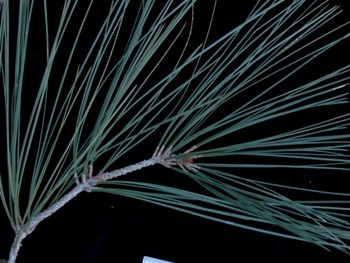Digger pine
(Pinus sabiniana)

Description
Pinus sabiniana (sometimes spelled P. sabineana), with vernacular names including towani pine, foothill pine, gray pine, and digger pine, is a pine endemic to California in the United States. Some sources discourage using the name "digger pine", considering it pejorative. The Pinus sabiniana tree typically grows to 36–45 feet, but can reach 105 feet (32 m) feet in height. The needles of the pine are in fascicles (bundles) of three, distinctively pale gray-green, sparse and drooping, and grow to 20–30 cm in length. The seed cones are large and heavy, 12–35 cm (4+3⁄4–13+3⁄4 inches) in length and almost as wide as they are long. When fresh, they weigh from 0.3 to 0.7 kilograms, rarely over 1 kilogram. The male cones grow at the base of shoots on the lower branches. Pinus sabiniana grows at elevations between sea level and 1,200 metres and is common in the northern and interior portions of the California Floristic Province. It is found throughout the Sierra Nevada and Coast Ranges foothills that ring the Central, San Joaquin and interior valleys; the Transverse and Peninsular Ranges; and Mojave Desert sky islands. The Native Plant Society of Oregon documents multiple specimens in Southern Oregon as well. It is adapted to long, hot, dry summers and is found in areas with an unusually wide range of precipitation: from an average of 250 mm (10 in) per year at the edge of the Mojave to 1,780 mm in parts of the Sierra Nevada. It prefers rocky, well drained soil, but also grows in serpentine soil and heavy, poorly drained clay soils. It commonly occurs in association with Quercus douglasii, and "Oak/Foothill Pine vegetation" (also known as "Oak/Gray Pine vegetation") is used as a description of a type of habitat characteristic within the California chaparral and woodlands ecoregion in California, providing a sparse overstory above a canopy of the oak woodland. Pinus sabiniana needles are the only known food of the caterpillars of the Gelechiid moth Chionodes sabinianus. Fossil evidence suggests that it has only recently become adapted to the Mediterranean climate as its closest relatives are part of the Madrean pine-oak woodlands found at higher elevations in the southwest US and Mexico. Some Native American groups relied heavily on sweet pine nuts for food and are thought to have contributed to the current distribution pattern, including the large gap in distribution in Tulare County. Native Americans also consumed the roots.
Taxonomic tree:







